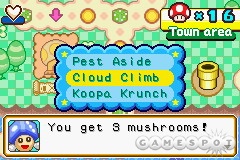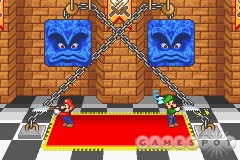Mario Party Advance may disappoint fans of the console Mario Party games who are looking to find the same communal experience on the go. That's because while the Game Boy Advance game includes more than 120 different minigames, only about a dozen of them support true four-player simultaneous play. Overall, the GBA game's multiplayer features are fairly limited and poorly organized. Its single-player component, on the other hand, is very nicely organized and offers a great deal of variety.

Mario Party Advance includes more than 120 minigames. Fifty of them are set up so that a single player has to accomplish whatever task is presented. When these games are played in one of the game's multiplayer modes, only one player can participate at a time. The other participants have to wait for their turns to come up and then try to beat the score or time that the earlier players set. Another 60 of the game's minigames are referred to as "gaddgets," which are useless tools and simple games that are entirely for fun and aren't included as part of the game's story or challenge modes. Gaddgets range from totally worthless, such as the love meter and the Morse code generator, to somewhat cool, like stand-alone darts and pinball games. Some gaddgets do support multiplayer play, but not in the way you'd expect. When you fire up a so-called multiplayer gaddget, each player is supposed to be in charge of a particular portion of a single GBA. One person controls the directional pad, one person controls the A and B buttons, one person controls the left shoulder button, and one person controls the right shoulder button. The remaining dozen or so minigames are of the true multiplayer variety that require a link cable and at least one other GBA. Some require only a single cartridge; others require each player to have a cartridge.
People often say that more isn't always better. That's true with regard to the minigames included in Mario Party Advance. While there are certainly a lot of them, the quality varies. Some are clever and involve such tasks as sneaking past Chain Chomps in a barrel or guiding Mario through one of Bowser's dungeons on a pogo stick. Some fall into the category of unoriginal yet tolerable, such as the various racing and platform-jumping minigames that duplicate tasks we've seen in countless action games and minigame collections in the past. A few are just downright terrible, like Bunny Belt, which forces you to input the same brief arrow pattern over and over again while Mario stands in front of a toy-making machine.
Most minigames and gaddgets must first be unlocked in the single-player story mode, which comes in the form of a dice-based board game. You roll dice and move your way across the game board to visit the various characters situated upon it. When you speak to characters, they'll challenge you to a minigame or send you to fetch something from another character on the board. If you beat their game or complete their errand, they'll give you one of E. Gadd's gaddgets, which is then unlocked on the main menu. You start out the story mode with a limited number of dice rolls, but additional dice rolls can be earned by successfully completing the minigames that come up every three turns or that are plainly indicated on the game board. Once you manage to complete a minigame in the story mode, it too becomes available as a stand-alone object from the main menu. There are times when the board game seems to drag on, especially when you're involved in a multipart fetch quest or get stuck on a particularly tough challenge, but the incorporation of the Mario characters along with the sheer variety of different games helps keep things fresh.
Once they're unlocked, each minigame and gaddget can be accessed from one of the options on the main menu. You can choose to tackle them individually in free-play or scored-based modes or in groups in one of the various challenge and attack modes.
In stark contrast to its single-player component, the game's multiplayer features are poorly implemented and aren't organized in a sensible manner. The dozen true multiplayer games, which require a link cable, are stand-alone options that aren't included as part of an overarching tournament mode. Some of the gaddget minigames support multiple players, but only to the extent that multiple people are supposed to share a single GBA by taking charge of specific buttons. A pair of challenge modes allow multiple players to compete to see who can get the highest score or best time in the 50 single-player minigames, and both can be played in a link-play or a pass-and-play fashion. Since the single-player minigames support only one player at a time, however, the other players have to wait for their turn to come up before they can play. That's hardly the same as the always-on nail-biting experience that the console Mario Party games served up.
It's strange that the board game is available only as a single-player option, since that's how multiplayer tournaments in the console games are organized. In fact, Nintendo must have realized at some point late in the game's development that people would miss the multiplayer board game, because they included a paper game board with the game, which can also be downloaded and printed from the game's official Web site. In theory, you are supposed to roll dice and let the game serve up minigames.

It's also somewhat surprising that Mario Party Advance doesn't look or sound as good as we've come to expect from late-generation GBA games. The character sprites are colorful, but many of the backgrounds are bland. That's especially true of the game board in the story mode, which looks like it was drawn with the 8-bit Game Boy Color in mind. Much of the animation that's used during the minigames and cutscenes is very simple as well. Sometimes there isn't any animation at all. On the upside, the Mario characters and scenery have been integrated seamlessly into the various minigames, cutscenes, and board game locations. You never get the feeling that this is just a collection of minigames with the Mario license slapped on. The music and sound effects were taken from the previous 8- and 16-bit Mario games, which also helps capture the property's unique flavor, although they haven't been filtered or enhanced to take advantage of the GBA's audio capabilities.
All told, Mario Party Advance is quite different from the Mario Party games we're familiar with on the N64 and GameCube. The majority of the minigames and play modes included with the GBA game are geared toward single-player play. That's not necessarily a bad thing, but it does mean that Mario Party Advance isn't much of a party when multiple players are involved.